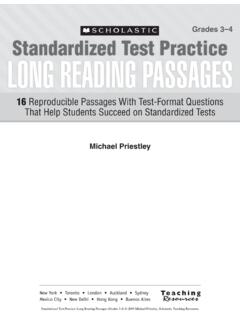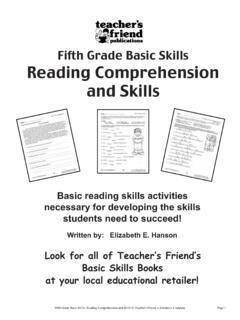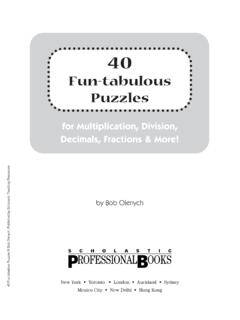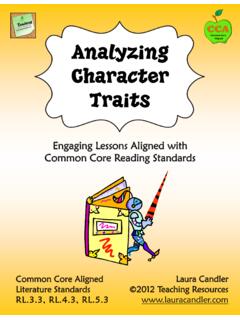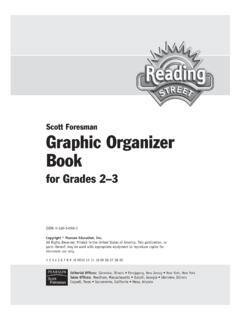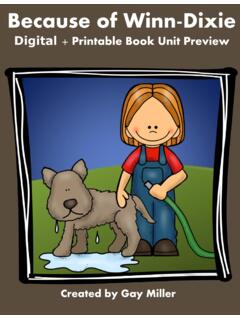Transcription of Short Reading Passages With Graphic Organizers
1 Linda Ward BeechGrades 2 3 Short Reading Passages With Graphic OrganizersScholastic Inc. grants teachers permission to photocopy the reproducible activity sheets in this book for classroom use. No other part of this publication may be reproduced in whole or in part, or stored in a retrieval system, or transmitted in any form or by any means electronic, mechanical, photocopying, recording, or otherwise, without written permission of the publisher. For information regarding permission, write to Scholastic Inc., 557 Broadway, New York, NY by Mela OttaianoCover design by Brian LaRossa / Interior design by Sydney WrightInterior illustrations by Maxie ChamblissInteractive whiteboard activities developed by Adam Hyman and designed by Brian LaRossaISBN-13: 978-0-545-23455-9 / ISBN-10: 0-545-23455-7 Copyright 2001, 2010 by Linda Ward Beech.
2 All rights reserved. Published by Scholastic in the 2 3 4 5 6 7 8 9 10 40 17 16 15 14 13 12 11 10 Short Reading Passages With Graphic Organizers to Model & Teach Key Comprehension Skills: Grades 2-3 Linda Ward Beech, Scholastic Teaching ResourcesIntroduction ..3 Concept Webs: Topic/Main Idea and DetailsFancy Fireworks ..6 Things to Do in Maine ..7 Picture a Pigeon ..8 The Inside Story ..9 State Stuff ..10A Fast Laugh ..11 What s for Lunch? ..12So Many Symbols ..13 Tracking Trains ..14 Testing It Out ..15 Sequence Webs: SequenceHello, Island! ..16 Turn on the Lights ..17 Here Come the Cranes ..18A Painted Cave ..19 Easy Opening ..20 Toys Through Time ..21 Balloons on Parade ..22 Testing It Out ..23 Venn Diagrams: ComparingOn the Ferry ..24 Looking at Leaves.
3 25 Foreign Flags ..26 Opposite Poles ..27A State Apart ..28 Tales of Whales ..29 Growing Up ..30 Testing It Out ..31 Charts: ClassifyingBuilding Blocks ..32 Play Ball ..33 Let s Celebrate ..34 Shaping Up ..35 Bag Tags ..36 Blending In ..37 Quilts of History ..38 Testing It Out ..39 Cause-and-Effect Maps: RelationshipsSilly Laws ..40 Cooling a Kampong ..41 Eat and Read ..42 Fool the Birds ..43 Excellent Elephants ..44 Where the Sun Shines ..45 Seeing Red ..46 Testing It Out .. Reading Passages With Graphic Organizers to Model & Teach Key Comprehension Skills: Grades 2-3 Linda Ward Beech, Scholastic Teaching Resources3In your hands, you hold a surefire way to engage even the most reluctant learners and build the Reading comprehension skills all students need to succeed. Using the 40 Short , high-interest Passages in this book , each paired with a Graphic organizer that supports its text structure, you ll find an easy way to help students learn how to find the main idea, understand cause and effect, compare and contrast, sequence events, and more.
4 The ready-to-use Notebook files in the Companion Folder contain activities that make it easy to model these essential Reading comprehension skills on your SMART Board. Following your lead, students can write, highlight, and underline key text right on the the Graphic Organizers {..{Many students are visual learners and can benefit greatly from using Graphic Organizers with their Reading . Graphic Organizers are especially helpful in identifying and sorting information. Different types of Graphic Organizers are particularly suited to certain types of text structures:W Concept webs focus on main ideas and supporting Sequence webs focus on sequential events or steps in a Venn diagrams focus on making comparisons. W Charts focus on classifying Cause-and-effect maps focus on identifying relationships between students complete a Graphic organizer , they do the following:W create a visual product based on their Reading W engage in understanding information from a passage W see relationships among words, facts, and ideas W gain a sense of purpose and control over their readingW learn to paraphrase what they readPoint out that there is often more than one way to group information from a passage.}}
5 Encourage students to fill in Graphic Organizers using their own words and phrases. (See the example on page 4.)Introduction{ TEAChER TIpS {W Suggest that students read the passage all the way through to get the general idea. Then they can reread it to identify the information needed in the If students are unfamiliar with a Graphic organizer , model its use before assigning the page. Think aloud as you read the passage, directions, and questions, and as you fill in the organizer . W Because of the limited amount of space on each page, you may want to make enlarged copies of some Graphic Organizers for students to use. You may also suggest that they draw larger versions of the Graphic Organizers on separate sheets of Use the MORE! activities found at the end of each reproducible Graphic organizer page to extend and expand students learning.}}
6 Short Reading Passages With Graphic Organizers to Model & Teach Key Comprehension Skills: Grades 2-3 Linda Ward Beech, Scholastic Teaching Resources4 The set of activities for each type of Graphic organizer progresses from easier, offering students more support, to more challenging, allowing students greater independence. For instance the first concept web (page 6) includes the topic and one detail. The final concept web (page 14), however, requires students to decide what the paragraph topic is and to identify all six examples that tell about the topic. The activities in between are scaffolded to provide an appropriate level of challenge for a range of skill levels. No matter their skill level, by building Graphic Organizers , students are more likely to understand and retain information for reports, quizzes, tests, and discussions.
7 Each section of the book concludes with a page called Testing It Out, which is set up as a typical bubble-style test. The test questions are always based on the passage on the preceding page. Students can easily see the relationship between creating a Graphic organizer and using that information on a test. Earth s Partsmantlecrustinner coreouter coreEarth s Partscrust on outsidemantle of hot rockinner core at centerouter core between inner core and mantleiron andnickelHere are two different ways students might present Reading Passages With Graphic Organizers to Model & Teach Key Comprehension Skills: Grades 2-3 Linda Ward Beech, Scholastic Teaching Resources5 Simply choose the lesson with the skill that you want to teach. Open the appropriate file on your interactive whiteboard and scroll to the lesson.
8 Each lesson is comprised of 2 slides:W a text-only slide featuring the paragraphW a Graphic organizer slideIt is a good idea to preview the lesson on your computer so that you fully understand the lesson as well as the best way to convey it to students on the interactive strategy you may find helpful is to use the colored pens in the interactive whiteboard s pen tray to help students who are visual learners. For example, circling, underlining, or highlighting the main idea of a passage in green and all of the supporting details in blue is a great way to organize information by color. For consistency, use the same colors to represent a concept when completing the Graphic Organizers . This will also help students who are filling in the Graphic organizer quickly identify key information if they need to refer back to the paragraph final slide in each file contains an interactive version of the Testing It Out Suggestions{.}
9 {W Be sure to use the activities that work best for the ability levels in your classroom. W Encourage students to explain their thinking as they complete the Have students work in cooperative groups to complete some activities. Assign roles such as reader (one who reads the passage to the group), highlighter (one who highlights relevant parts of the passage), mapper (one who fills in the Graphic organizer ), and checker (one who reviews the completed Graphic organizer to be sure it is correct). Encourage group members to switch roles.{ TEAChER TIpS {W While the interactive whiteboard lessons are perfect for whole-group learning, you can also use the Notebook instruction, differentiated instruction, and enrichment. The additional lessons can be printed or photocopied for in-class practice, homework, and As you model how to use a Graphic organizer , pass out reproducible versions of the activity you choose to display, along with colored pencils, pens, or highlighters.}}}
10 Ask students to mark up their own copies as they follow To extend learning invite students to continue building onto the Graphic organizer with additional information they may already know.{..{How to Use the Companion Folder and Interactive WhiteboardIn the Companion Folder, you ll find five Notebook files that correspond to each section of the bookand focus on a different type of Graphic for mini-lessons, small-group Short Reading Passages With Graphic Organizers to Model & Teach Key Comprehension Skills: Grades 2-3 Linda Ward Beech, Scholastic Teaching Resources6 Name _____ Date _____Kaboom! It s the Fourth of July. Fireworks light up the night. Have you ever seen a willow firework? It has long trails of color that float to the ground. The pinwheel and comet are two other popular fireworks.}}
